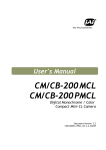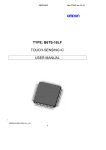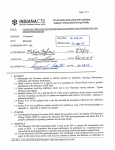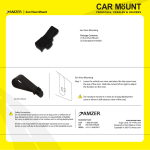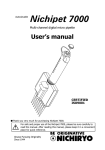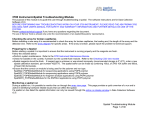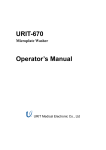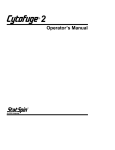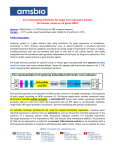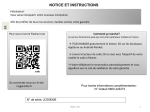Download DNA Quality Control
Transcript
Page 2 of 5 3.1. Quality Control of DNA is performed by various methods. The SSF performs QC of DNA by using a spectrophotometer emitting UV light and measuring absorbance at two different wavelengths to determine the concentration and purity (260/280 ratio) of the DNA. 4. SCOPE 4.1. This SOP applies to all SSF personnel performing QC of DNA. It defines the process of obtaining the concentration and the 260/280 ratio for DNA samples using the Nanodrop model ND-1000 spectrophotometer. 4.2. All SSF processing SOPs may be superseded by specific directives from the investigator as directed in SF-4-1. Initial entry into the worksheet will define whether there are specific processing directives applicable to a specimen. 5. MATERIALS 5.1. Reagents 5.1.1. DI water (from lab sink) 5.1.2. FG3 Hydration Buffer, stored at room temp (Qiagen Cat. # 1023542), or another hydration buffer that was used to rehydrate the DNA. 5.2. Supplies 5.2.1. Kimwipes® (or similar product) 5.2.2. Pipette tips 5.3. Equipment 5.3.1. Bar-code Scanner 5.3.2. Nanodrop ND-1000 Spectrophotometer, appropriate for measuring absorbance at a wavelength range of 260 through 280 (SF-3-11) 5.3.3. Pipette(s) (or other suitable dispensing unit) capable of dispensing 2uL – 60uL of a liquid sample (SF-3-3) 5.3.4. Vortex 5.3.5. Eppendorf Thermomixer 6. PROCEDURE NOTE: Record on the applicable extraction worksheet if exceptions to this SOP per SF-4-1 are applicable. NOTE: Store DNA samples in -80°C for long term storage unless otherwise stated per SOP SF-4-1 Management Requests for Sample Processing Support. Resolve all discrepancies for sample receipt per SOP SF-4-1. 6.1. Operation for the Nanodrop ND-1000 Spectrophotometer for DNA QC 6.1.1. Log in and machine preparation 6.1.1.1. Using IU login and password, access the Nanodrop ND-1000 operating software installed on the computer connected to the instrument. 6.1.1.2. Double click on the Nanodrop icon to open the menu screen. 6.1.1.3. Click the Nucleic Acid button which prompts an instruction window to open reading, “Ensure sample pedestals are clean and then load a water sample. After loading water sample, click OK to initialize instrument.” 6.1.1.4. Clean lower and upper pedestals on the Nanodrop by dropping distilled (DI) water on them and dry with a Kimwipe® (or similar product). 6.1.1.5. Load 2µL of DI water on the lower pedestal using a pipette. 6.1.1.6. Close the sample arm. SOP SF-4-16.02 SOP FOR DNA QC Page 3 of 5 6.1.1.7. Click the OKAY button. 6.1.1.8. Clean the upper and lower pedestals when the Nanodrop finishes analyzing the sample (~3-5 seconds). 6.1.1.8.1. Raise the sample arm and clean the sample off both pedestals with a dry Kimwipe® (or similar product). 6.1.1.9. Make a BLANK measurement and perform an initial QC (to be performed at the beginning of every DNA batch analysis): 6.1.1.9.1. Obtain the name of the hydration solution used in the DNA extraction procedure from the applicable DNA processing sheet or Autogen report. Utilize this solution to make a BLANK measurement. 6.1.1.9.2. Load 2µL of the hydration solution to the lower pedestal with a pipette, close the sample arm, type the name, lot number, and expiration date of the hydration solution, and click the BLANK button. 6.1.1.9.2.1. If the same hydration solution that was used to rehydrate the DNA is not available, store the samples in 4°C until the solution can be obtained. If it cannot be obtained, use another hydration solution and make note of actions on the final Nanodrop data printout. 6.1.1.9.3. Clean the upper and lower pedestals when the Nanodrop finishes analyzing the sample (~3-5 seconds). 6.1.1.9.3.1. Raise the sample arm and clean the sample off both pedestals with a dry Kimwipe® (or similar product). 6.1.1.9.4. Type the name and lot number of the solution used to blank the equipment in the software menu’s Sample ID box. 6.1.1.9.5. Again, Load 2µL of the hydration solution to the lower pedestal with a pipette, close the sample arm, and click the OK button. 6.1.1.9.6. Clean the upper and lower pedestals when the Nanodrop finishes analyzing the sample (~3-5 seconds). 6.1.1.9.6.1. Raise the sample arm and clean the sample off both pedestals with a dry Kimwipe® (or similar product). 6.1.1.9.7. View the resulting spectrum on the screen. The result should be a spectrum with a relatively flat baseline. 6.1.1.9.7.1. If this is the case, proceed to section 6.1.2. 6.1.1.9.7.2. If the spectrum does not show a flat baseline, repeat all steps in Section 6.1.1.9 until it does. 6.1.1.9.7.3. If, after several blanking attempts, the spectrum still does not show a flat baseline, reference The Nanodrop User’s Manual (Trouble Shooting) in SF-3-11. 6.1.2. Measuring DNA samples for concentration and purity 6.1.2.1. Obtain DNA and applicable processing worksheet for recording values. 6.1.2.2. Mix sample thoroughly prior to loading by gently vortexing for a few seconds. 6.1.2.3. In the software menu’s Sample ID box, scan (using bar-code scanner) or type in the sample’s ID. If a particular sample is being repeated, the identification should be in the format “Sample ID-redo.” If additional repetitions are warranted, then the format would be “Sample ID-redo2,” etc. SOP SF-4-16.02 SOP FOR DNA QC Page 4 of 5 6.1.2.4. Load 2µL of sample onto the lower sample pedestal with a pipette, close the sample arm, and click the OKAY button. 6.1.2.5. Clean the upper and lower pedestals when the Nanodrop finishes analyzing the sample (~3-5 seconds). 6.1.2.5.1. Raise the sample arm and clean the sample off both pedestals with a dry Kimwipe® (or similar product). 6.1.3. Repeat the process outlined in steps 6.1.2.2 through 6.1.2.5.1 for all samples until the completion of the batch of samples has been analyzed. 6.1.3.1. If there are any errors, reference The Nanodrop User’s Manual (Trouble Shooting) and SF-3-11 as necessary and repeat the reading. 6.1.3.2. If the 260/280 ratio for any sample is less than 1.7 or the required ratio defined by the PI on Appendix A of SF-4-1 SOP for Managing Requests for Sample Support, repeat the reading (steps 6.1.2.2 through 6.1.2.5.1) for that sample. 6.1.3.2.1. If the 260/280 is still less than 1.7 or the required ratio defined by the PI on Appendix A of SF-4-1 SOP for Managing Requests for Sample Support, document explanations and/or actions taken on applicable processing sheet or QC data printout. (for obtaining the QC data printout, see Section 6.1.4). If necessary, consult a technical advisor. 6.1.3.3. If the concentration for any sample is greater than 700ng/ul, the sample may require additional rehydration steps. 6.1.3.3.1. Add an additional 200ul FG3 Hydration Buffer, or other applicable buffer, to the sample. Additional buffer may be added to samples of very high concentration. 6.1.3.3.2. Place sample on Thermomixer overnight or for an equivalent amount of time with the Thermomixer set at 65°C and 1100 rpm. 6.1.3.3.3. Measure concentration and purity again as outlined in Section 6.1.2. 6.1.3.3.4. Repeat steps outlined in this section as necessary until the concentration is under 700ng/ul. 6.1.3.3.5. Document explanations and/or actions taken on applicable processing sheet or QC data printout. 6.1.3.4. Additionally, the analysis of a sample may be repeated at the discretion of the SSF technician for any reason he/she may deem necessary. For example, the technician may feel that the technique he/she used to analyze the sample in question was not optimal. 6.1.3.5. Document explanations and/or further action taken for samples that needed repeating on the applicable processing worksheet or the QC data printout (for obtaining the QC data printout, see Section 6.1.4). 6.1.4. Naming, saving, and storing the data 6.1.4.1. Click the Show Report button on the menu screen. 6.1.4.2. Click the Report name and type in the Run Identification number found on the applicable processing worksheet. 6.1.4.3. Click the Reports tab (top left of window) and use the drop down menu to select Save Report. 6.1.4.4. Click the “Export Report Table Only” in the new window that appears. 6.1.4.4.1. Verify that the filename is the same as the Run Identification number listed in section 6.1.4.2 of this SOP. SOP SF-4-16.02 SOP FOR DNA QC Page 5 of 5 6.1.4.5. Save the text file in the Specimen Storage Facility NanoDrop data shared folder. File name should include last two digits of the current calendar year, batch number and initials of person that spec’d the samples. 6.1.4.6. Convert the text file into an Excel document and save in the NanoDrop data shared folder. 6.1.4.7. Record QC data (260/280 ratio & DNA concentration) by attaching a printout of the Excel document to the applicable DNA processing worksheet. 6. REFERENCES 7.1. Nanodrop ND-1000 Spectrophotometer V3.8 Users Manual 7.1.1. Located in the SSF shared folder 7.1.2. Alternatively, downloadable from the support section of the Nanodrop website (http://nanodrop.com/) 8. DOCUMENTATION 8.1. Records are maintained per SF-1-6 Controlled Document Management. 8.2. Deviations are managed per the SF-1-9 Deviation Management SOP. Of special note, per scope of this SOP, complying with investigator specific directives per SF 4-1 is not a deviation to this SOP but is noted on the applicable worksheet. 9. APPENDICES 9.1. The current version of the following appendices are used to implement this SOP: None (DNA readings are placed with the applicable DNA extraction worksheet). SOP SF-4-16.02 SOP FOR DNA QC






